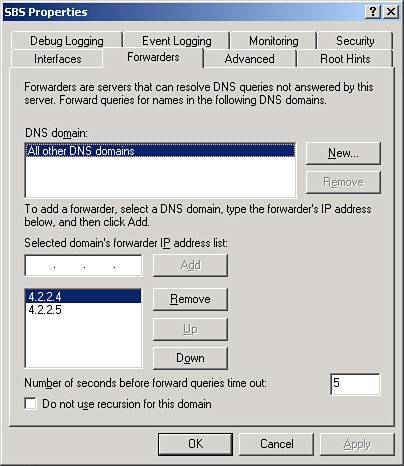Configuring DNS to Resolve Public Internet Addresses
| So how does the DNS Server service provide name resolution for public Internet addresses if both network cards point to the SBS server for DNS resolution? For that, we need to look again at the DNS Management Console. Using DNS Forwarders in the DNS Management ConsoleWhen the DNS Management Console comes up, right-click on the server name and select Properties; then click on the Forwarders tab. The dialog box shown in Figure 5.3 appears. The DNS Domain box should have one entry named All Other DNS Domains. The Selected Domain's Forwarder IP Address List box should have the IP addresses for your ISP's DNS servers listed. You should expect to see this configuration after the Connect to the Internet Wizard has been run on the server. Figure 5.3. The DNS Management Console displays the DNS forwarder addresses. As described earlier in this chapter, if the DNS service receives a request for an address that is not in its configuration, it first looks to its internal DNS cache for the address. If one is not found, the DNS Server service then contacts the first IP address listed in the Forwarders section and requests the address from that server. A second DNS server IP is strongly recommended in the case where the first server cannot be contacted for some reason. Using Root Hints in the DNS Management ConsoleBeing able to use DNS servers provided by the ISP helps reduce the DNS server load. When the DNS server cannot find an address in its local table or local cache, it makes one request to the ISP's DNS server and lets that server do all the lookup work necessary to find the address. The DNS Server service does not have to use external DNS forwarders, however. The DNS Server service can make use or root hint servers and handle all the lookups itself instead of handing them off to the forwarder. If no IP addresses are listed in the Forwarders tab of the server properties in the DNS Management Console, the DNS server will automatically query the root hint servers listed in the Root Hints tab of the properties window. These root hint servers do not contain any DNS address information themselves, but they do contain addresses for other DNS servers that do provide the address information. When a DNS query comes in to the SBS DNS server for a server on the public Internet, the DNS service first queries the appropriate root hint server to find a DNS server to use to resolve the name; then will sends another query to that server to get the actual address to pass back to the client.
|
EAN: 2147483647
Pages: 253
